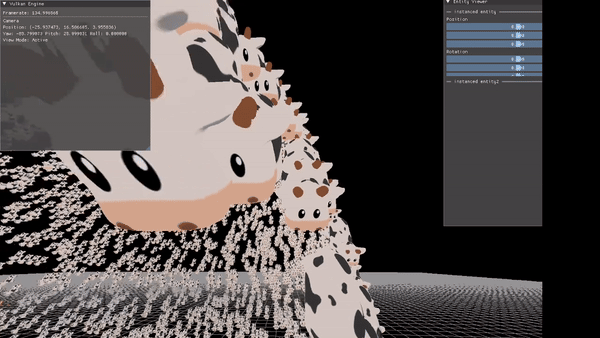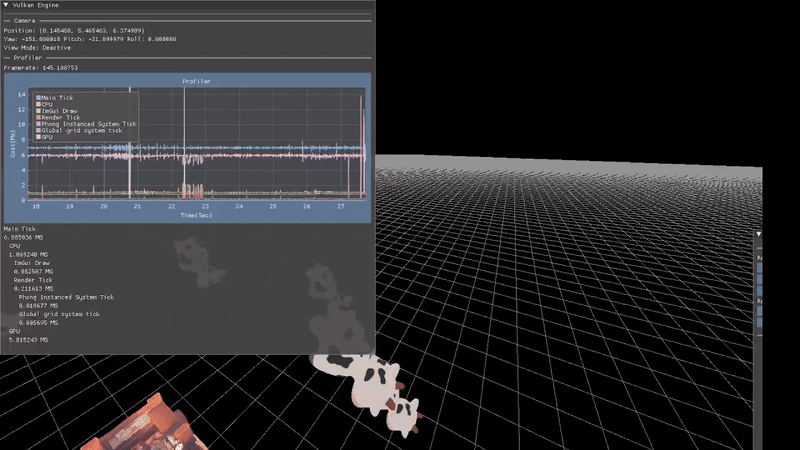It's like writing an OS
nobody uses windows anyways
Grab Vulkan SDK
git submodule update --init --recursive
mkdir build
cd build
cmake -G "Ninja" ../
ninja
Grab Vulkan SDK
Specify path to the library, as well as include folder, in CMakeLists.txt
Note that Apple build uses MoltenVK to link to metal.
Extensions such as VK_KHR_PORTABILITY_SUBSET_EXTENSION_NAME must be enabled to setup
the translation layer.
Some extensions may not work.
- graphics pipeline abstractions
- basic game entity abstractions
- object viewer window
- a fancy profiler UI
- global instancing -- instance everything
- instance clustered frustum culling
- indirect rendering
- a performant object instance GC?
Instanced rendering of 5000 cows. Every entity is backed by instanced rendering so the programmer doens't need to worry about doing instancing themselves. Instance data such as transform & texture, live in GPU and the engine provides nice abstractions to update them.
Creating 3d objects is as:
extern InstancedRendererSystem* renderer;
for (int i = 0; i < INSTANCE_NUM; i++) {
Entity* cow = new Entity("cow");
InstanceRenderingComponent* instanceComponent =
renderer->MakeInstanceComponent("cow.obj", "cow.png");
cow->AddComponent(instanceComponent);
cow->AddComponent(new TransformComponent());
// demo to update position
auto position = RandomPosition()
cow->GetComponent<TransformComponent>()->position = position;
cow->GetComponent<InstanceRenderingComponent>()->FlagAsDirty(cow);
// this tells the renderer that we have modified some structure that affects instanced rendering.
// The renderer will take care of the rest
}Global instanced&indirect rendering offloads what would be handled by the CPU --
the bindVertexBuffer(), bindIndexBuffer(), setUniform(), and bindTexture() calls,
to the GPU.
Instead of directly binding the buffers, the GPU uses a series of indices to index into multiple global arrays to retrieve information relevant to the mesh.
Mesh instances differ in 3 types of resources they traditionally need to bind to / get from uniform:
- Vertex & Index buffer
- texture(normals, albedo, phong, pbr, etc...)
- instance-specific data -- data that is seldomly shared among multiple instances
- e.g. model matrix, transparency
Each of the above types, can be generalized as a "data structure", that we put into an array. The shaders/GPU APIs are then capable of indexing into them.
Specifically:
- for each different vertex/index, reserve an array element on GPU to store them.
Giant vertex buffer that contains vertices of all meshes
Mesh 1(offset=0) Mesh 2(offset=4) Mesh 3(offset=7)
| | |
| | |
|Vertex 1|Vertex 2|Vertex 3|Vertex 4|Vertex 5|Vertex 6|Vertex 7| ....|Vertex N
Giant index buffer that contains indices of all meshes
Mesh 1(offset=0) Mesh 2(offset=3) Mesh 3(offset=9)
| | |
| | |
|Index 1|Index 2|Index 3|Index 4|Index 5|Index 6|Index 7|Index 8|Index 9|.... | Index N
- for each texture, reserve an array element for store.
|Texture 1|Texture 2|Texture 3| ....
- for each instance-specific data of an instance, pack them into a struct and store them a giant SSBO. Also pack in offset to textures:
struct Instance
{
mat4 model;
float transparency;
int albedoOffset;
int normalOffset;
int roughnessOffset;
};|Instance 1|Instance 2|Instance 3| ....
- For each mesh, create a
vk::DrawIndexedIndirectCommandthat contains:
- number of instances to draw
- number of indices to use, starting from the base index
- base index to start, when reading the
index buffer array- for example, for
Mesh 2above, set the offset to 3
- for example, for
- offset to the base vertex, when reading the
vertex buffer array- for example, for
Mesh 2above, set the offset to 4.
- for example, for
|DrawCMD1 |DrawCMD2 |DrawCMD3 |DrawCMD4 |DrawCMDN
Note that all the above arrays are store on the GPU
At render time, the vulkan API provides the vkCmdDrawIndexedIndirect call,
that iterates over all the draw commands, in parallel, and executes the draws.
Note that the tight layout of mesh instances in the SSBO also provides opportunities for compute shader to modify instance data -- such as transforms, in parallel.
In the shaders, gl_InstanceIndex can be used to access into the correct instance
lookup array, and therefore instance data array.
The above implementation may work well when we have a fixed number of instances. But let's also shed light on the following complex runtime cases:
- we assume the GPU is capable of having large enough VRAM to
store all vertex & index buffers of a scene. The cost is estimated to be small;
estimating a rough 1,000 different meshes, with 3,000 vertex + indices in each,
leads to 3,000,000 vertices. Giving the conservative assumption that, each vertex/index consists of 5
vec3-- 60 bytes each, storing all vertices/indices on GPU would cost60 * 3,000,000 / 1e-6=180 mbof vram -- a relatively small tax on the GPU, if we put electron apps into context.
Instanced&indirect rendering adds complexity to choosing which instance to render. This is important for unloading mesh instances from the scene, and more importantly, instance culling.
A traditional & native rendering pipeline would do the following:
extern std::vector<MeshInstance*> _instances;
for (MeshInstance* instance: _instances) {
setUniform("model", mesh->modelMat);
bindVertexBuffer(instance->vertexBuffer);
bindIndexBuffer(instance->indexBuffer);
bindTexture("albedo", instance->albedoTexture);
//...
drawCall();
}Removing an instance is as simple as popping it from the vector on the CPU side.
However, when doing indirect rendering, we only have control over the number of instances to render, as well as write access to the instance data array.
Given that we wish to indirect & instance render everything, the following each presents a solution and tradeoffs:
- "Replace and decrement"
This is a rather simple solution. As we keep track of the total number of instances to render,
when removing an arbitrary instance, we:
a. copy over the last instance's data to the removed instance.
b. decrement the number of instances in the instance array by one.
Before:
|Instance 1|Instance 2|Instance 3| ....
After(remove 1):
|Instance 3|Instance 2| ....
The main overhead of the solution comes from copying over instance data -- which would become a problem when done in quick succession: for example, when the frustum-culled camera rapidly turns around, many instance data end up getting copied over and over. The CPU also has to re-flush the instance data back to the buffer, after their removal.
However, for simple removal of mesh instance(implying the instance is never to be rendered again), the method works well.
- "Replace and decrement" with an additional layer of indirection
We create an additional "Instance Index" array, and similar to the "Replace and decrement" method -- we perform such operation on the array. The index array points to the instance datas, whereas the instance data array remains unchanged.
The overhead of this method has been significantly reduced -- as one only needs to shuffle around the index array of 4 byte entries.
The instance lookup array scheme almost sound like vm page table; maybe we can take a page(aha) from it?
To summarize, an object instance can have three states:
- it wants to be rendered
- it does not want to be rendered(culled)
- it wants to be deleted
the "Replace and decrement" method handles case 2 by doing a 8-byte memory write per instance: 4 byte to copy over the instance data at the end of the instance lookup array to the "empty" slot, and 4 byte to update the corresponding draw command's instance count.
as for case 3, in addition to the "replace and decrement", we also flag the instance's data in the instance data array as free(currently using a free list). So that new instance data creation can simply use the slot.
For instance addition, one can simply look at the instance data array and either append or insert to the free list, then create a corresponding entry in the instance lookup array.
Occulusion culling and frustum culling can be parallelized on the GPU as well. To do so, we need an additional array that points to all instances to be culled.
We also forgo the previous "replace and decrement" design; observing that most of the mesh instances of a 3d scene would be culled away by frustum culling. We opt the opposite: "add and increment":
CPP pseudocode:
extern vector<MeshInstance> instances; // actual array of all instances
extern vector<DrawCmd> drawCmds; // actual array of all drawcmds
extern vector<int> instanceIndices;
struct DrawCmd
{
int firstInstance;
int instanceNumber;
//...
};
struct IndexS
{
int dataIndex;
int drawCmdIndex;
};
extern vector<IndexS> activeInstances;
extern bool IsVisible(MeshInstance& instance); // culling function
for (const IndexS i: activeInstances) {
int dataIndex = i.dataIndex;
int drawCmdIndex = i.drawCmdIndex;
if (IsVisible(instances[dataIndex)) {
// atomic add returns the number before add, which we use as index
int slot = atomicAdd(drawCmds[drawCmdIndex].instanceNumber, 1);
int slotOffset = drawCmds[drawCmdIndex].firstInstance + slot; // offset in the global instance array
instanceIndices[slotOffset] = dataIndex; // so that drawCmd would reach the data index
}
}The for loop above can be parallelized using compute shaders.
To simplify the number of data structures, we may choose to integrate IndexS into MeshInstance data structure.
Each MeshInstance therefore contains additional metadata other than that required for rendering.
Note this design invalidates the "free list" mesh instance deletion method. Namely we need to perform "copy and decrement" on mesh instance deletion.
A fancy profiler GUI to show performance metrics, inspired by my own work on an nvidia internal profiler
Profiling entries are declarative and bound to scope. This means one can easily profil a function by simply inserting a macro as follows:
void UpdateEnginePhysics(Context* ctx) {
PROFILE_SCOPE(ctx->profiler, "engine physics update");
// .. bunch of transforms, culling, buffer shoving around etc
}
// profiler goes out of scope here, and the entry "engine physics update" will get recordedjust had the strangest memory bug i've ever experienced.
const std::array<VkVertexInputBindingDescription, 2>* Vertex::
GetBindingDescriptionsInstanced() {
static std::array<VkVertexInputBindingDescription, 2> bindingDescriptionsInstanced;
static bool initialized = false;
if (!initialized) {
// bind point 0: just use the non-instanced counterpart
bindingDescriptionsInstanced[0] = GetBindingDescription();
// bind point 1: instanced data
bindingDescriptionsInstanced[1].binding = 1;
bindingDescriptionsInstanced[1].stride = sizeof(VertexInstancedData);
bindingDescriptionsInstanced[1].inputRate = VK_VERTEX_INPUT_RATE_INSTANCE;
initialized = true;
}
return std::addressof(bindingDescriptionsInstanced);
}the above function returns an address to a stack-allocated static variable
All the values are correct initialized and written into. However as soon as the function returns, the variable gets re-initialized into its original values.
Same bug happened to my TextureManager singleton, where the stack-allocated singleton seems to have gotten zero-initialized.
Update: turns out it's a memory corruption of me trying to write to another stack-allocated static variable that overwrites into other parts of the code section. Segfault didn't happen because all the memory operations the program was doing was smearing over the static section.


